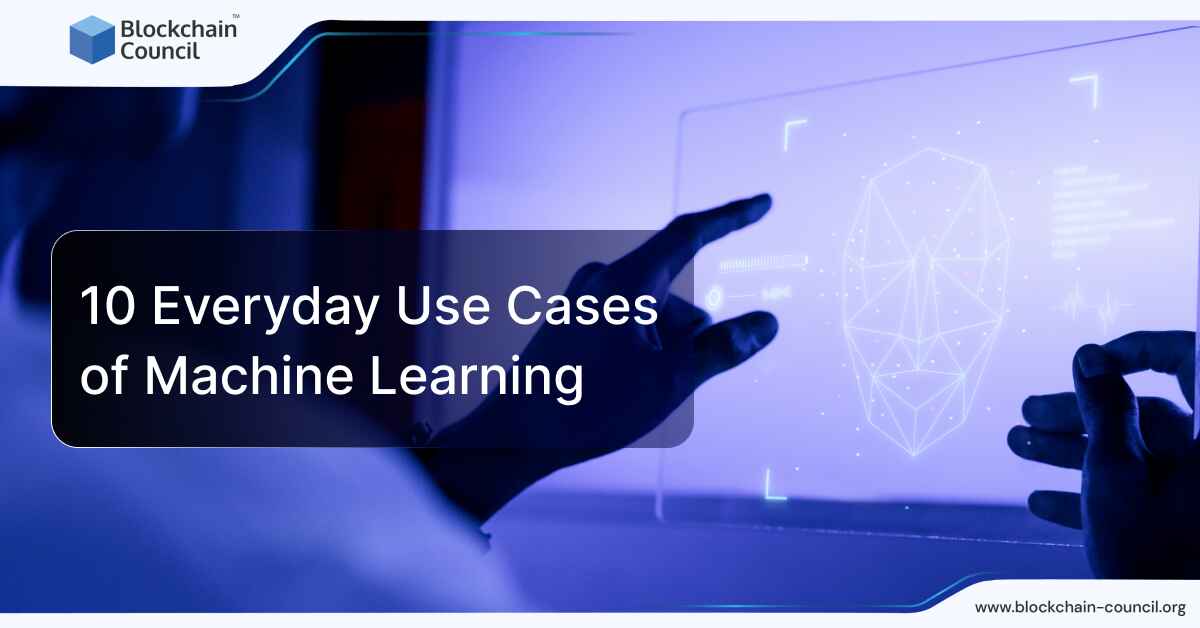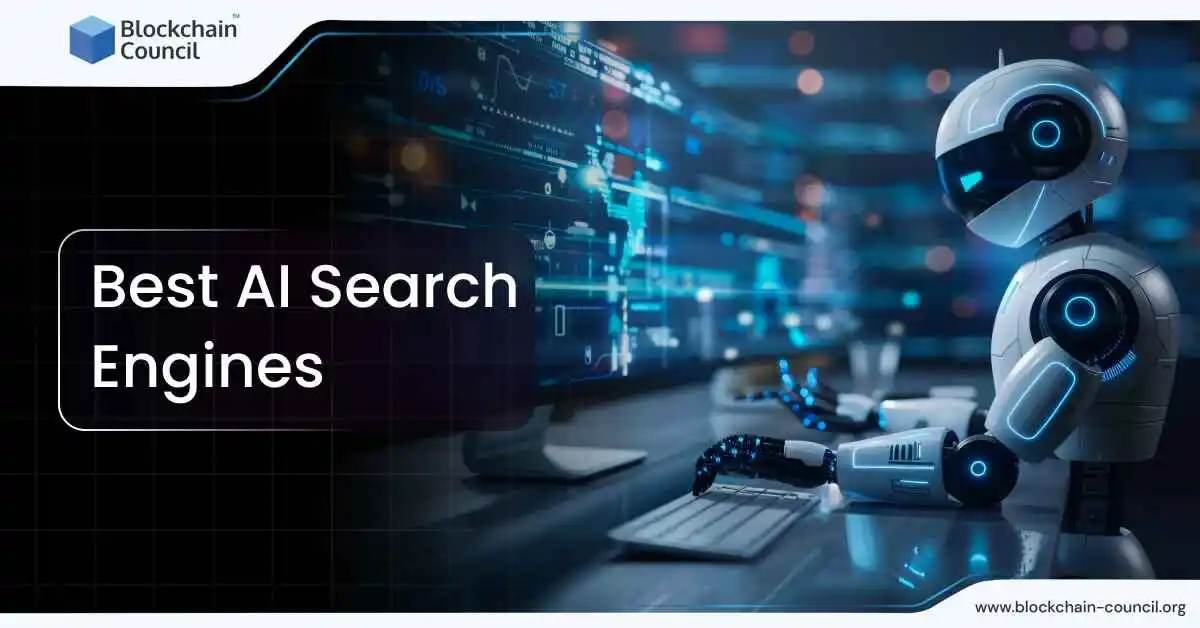
- Blockchain Council
- January 16, 2025
Machine Learning (ML) is a transformative force in today’s technology landscape, influencing a wide array of sectors and daily activities. At its core, ML utilizes algorithms and statistical models to allow computers to perform tasks without explicit instructions, learning from data. The field encompasses various learning types, including supervised, unsupervised, and reinforcement learning, each catering to different applications and challenges.
From enhancing personal convenience to revolutionizing industries, machine learning applications are vast and varied. This article explores ten everyday use cases of machine learning, showcasing its importance and ubiquity in our daily activities.
Top 10 Everyday Use Cases of Machine Learning
1. Virtual Personal Assistants
Virtual Personal Assistants (VPAs) represent a major leap in how individuals interact with digital devices. By leveraging advanced natural language processing (NLP) and machine learning algorithms, these assistants can understand and execute a wide array of tasks based on verbal or written instructions. Their evolution began with simple pattern-matching programs like ELIZA in the 1960s, and has since progressed to sophisticated systems capable of engaging in natural conversation, learning from interactions, and even performing tasks without explicit commands. Today’s VPAs, integrated into smartphones, smart speakers, and various online platforms, offer unprecedented convenience and efficiency in managing daily routines, accessing information, and controlling smart home devices.
Real-life Examples
- Siri (Apple Inc.): Launched in 2011 as part of the iPhone 4S, Siri was a pioneering VPA enabling users to perform tasks such as sending messages, setting reminders, and conducting web searches through voice commands. It has continuously evolved, now supporting a wide range of functions across Apple devices, including smart home management through HomeKit.
- Google Assistant: Introduced by Google, this assistant stands out for its ability to process natural language to perform tasks, manage schedules, and get information from the web. It’s known for its integration across Android devices, smart home gadgets, and the ability to understand context and remember user preferences for a personalized experience.
- Amazon Alexa: Launched alongside the Amazon Echo smart speaker, Alexa has become synonymous with voice-activated smart home control. It can play music, provide news updates, set alarms, and control smart devices. Alexa’s skills are continually expanding, making it a versatile assistant in both personal and smart home contexts.
2. Recommendation Systems
Recommendation systems are integral to enhancing user experience on digital platforms by suggesting products, services, or content based on user preferences and behavior. These systems utilize complex algorithms analyzing past behavior, similarities between users, and item attributes to predict and present the most relevant suggestions. Their application spans various sectors, including e-commerce, streaming services, and social media, significantly impacting decision-making and discovery processes.
Real-life Examples
- Netflix: This streaming service uses sophisticated algorithms to recommend movies and TV shows based on individual viewing histories and the preferences of similar users. It’s a prime example of a personalized content discovery experience that keeps users engaged.
- Amazon: Amazon’s recommendation engine is pivotal in its e-commerce dominance, suggesting products based on browsing history, purchases, and items in the shopping cart. This personalized approach enhances the shopping experience and increases the likelihood of purchases.
- Spotify: Known for its music discovery algorithms, Spotify recommends songs, artists, and playlists through its “Discover Weekly” feature, which personalizes content based on listening history and what similar users enjoy.
Also Read: Deep Learning vs Machine Learning vs Artificial Intelligence: A Beginner’s Guide
3. Email Filtering and Spam Detection
Email filtering and spam detection technologies are essential for maintaining the integrity and usability of email communication. By utilizing machine learning and NLP, these systems can identify and segregate unsolicited or harmful content from legitimate messages. This not only protects users from potential threats like phishing and malware but also improves productivity by reducing clutter in the inbox.
Real-life Examples
- Gmail: Google’s email service employs advanced spam detection algorithms to filter out spam and phishing emails with high accuracy, using user feedback to continuously improve its filtering accuracy.
- Outlook.com: Microsoft’s email platform utilizes similar machine learning techniques to protect users from spam and phishing attempts, offering a clean inbox experience and security measures to detect suspicious messages.
- Yahoo Mail: This service provides robust spam and security features, using advanced algorithms to keep unwanted emails out of users’ inboxes and protect them from potential threats.
4. Social Media Feeds
Social media platforms use machine learning algorithms to curate and prioritize content in a user’s feed, aiming to enhance engagement by displaying posts, news, and advertisements likely to be of interest. These recommendation systems analyze user interactions, relationships, and content preferences to create a personalized experience, keeping users informed and engaged with relevant content.
Real-life Examples
- Facebook: Utilizes complex algorithms to personalize news feeds, showing content from friends, family, and pages that align with the user’s past interactions and preferences.
- Instagram: Also owned by Meta (formerly Facebook), Instagram curates feeds and stories based on user behavior, relationships, and the content they engage with, including exploring new content through its “Explore” tab.
- Twitter: Employs a mix of chronological and algorithmic sorting to display tweets, emphasizing content from accounts users interact with frequently and topics of interest to keep the feed relevant and engaging.
5. Banking and Fraud Detection
The banking sector has significantly benefited from machine learning in detecting and preventing fraudulent transactions. By analyzing patterns of behavior and transaction data, algorithms can identify anomalies that may indicate fraud, reducing financial losses and safeguard customer assets. These systems can quickly adapt to new fraudulent techniques, ensuring banks and their customers are always a step ahead of potential threats.
Real-life Examples
- HSBC: Utilizes advanced AI technologies for real-time fraud detection, analyzing transaction patterns to spot unusual activities that could indicate fraud, significantly reducing the incidence of financial crimes.
- JPMorgan Chase: Implements machine learning algorithms to identify patterns indicative of fraudulent activities across its vast network of transactions, enhancing the security of customer accounts and the banking ecosystem.
- PayPal: Employs sophisticated fraud management tools that use machine learning to analyze transactions in real-time, helping to prevent fraudulent account use and protect user data and finances effectively.
6. Smart Home Devices
Smart home devices leverage machine learning algorithms to enhance the convenience, efficiency, and security of living spaces. These intelligent systems learn from users’ behaviors and preferences to automate tasks such as lighting, temperature control, and security monitoring. By analyzing data collected from interactions and sensors, machine learning enables these devices to predict users’ needs and adjust settings accordingly, providing a personalized and adaptive home environment.
Real-life Examples
- Nest Thermostat: This smart thermostat uses machine learning to learn a homeowner’s habits and preferences to adjust home temperature automatically, optimizing comfort and energy efficiency.
- Ring Video Doorbell: By employing machine learning algorithms, Ring analyzes video footage in real-time to distinguish between people, vehicles, and animals, sending relevant notifications to the homeowner and reducing false alarms.
- Philips Hue: Philips Hue smart lighting systems use machine learning to adapt lighting based on time of day, presence detection, and even syncing with multimedia content, creating personalized lighting scenes that enhance user experiences.
Also Read: Top 10 Machine Learning Projects In 2024
7. Traffic and Navigation Systems
Traffic and navigation systems powered by machine learning significantly improve travel efficiency and safety. These systems analyze vast amounts of data from various sources, including GPS devices, sensors, and historical traffic patterns, to provide real-time traffic updates, optimal routing, and predictive traffic flow models. Machine learning algorithms can identify patterns and predict potential bottlenecks, suggesting alternative routes to minimize travel time and avoid congestion.
Real-life Examples
- Google Maps: Utilizes machine learning to analyze current traffic conditions, historical data, and accidents reports to offer the fastest routes to its users.
- Waze: A community-driven navigation app that applies machine learning to user-reported data on traffic, hazards, and police presence to provide real-time routing adjustments and alerts.
- TomTom: Uses machine learning in its navigation devices to predict traffic flows based on time of day and historical traffic data, helping drivers avoid congested areas.
8. Language Translation Services
Language translation services have been revolutionized by machine learning, breaking down language barriers and facilitating global communication. These services use neural machine translation (NMT) techniques that learn from vast datasets of translated texts to produce more accurate and contextually relevant translations. Machine learning enables these systems to understand nuances, idioms, and cultural specificities, providing translations that are not just literal but also contextually appropriate.
Real-life Examples
- Google Translate: Offers real-time language translation for text, speech, and images in over 100 languages, using machine learning to improve accuracy and context understanding.
- DeepL Translator: Renowned for its superior translation quality, DeepL uses advanced machine learning algorithms to understand text context and provide nuanced translations.
- Microsoft Translator: A machine learning-powered service that supports text, speech, and document translation across multiple platforms, ensuring seamless communication in various languages.
9. Health and Fitness Trackers
Health and fitness trackers use machine learning to provide insights into users’ physical well-being and activity levels, promoting healthier lifestyles. By analyzing data from sensors tracking heart rate, steps, sleep patterns, and more, these devices offer personalized recommendations, activity tracking, and health monitoring. Machine learning algorithms process the collected data to identify trends, set goals, and even detect potential health issues early, encouraging proactive health management.
Real-life Examples
- Fitbit: Incorporates machine learning to analyze activity, sleep, and heart rate data, offering personalized fitness coaching and health insights.
- Apple Watch: Uses machine learning to monitor heart health, detect falls, and track various fitness activities, providing users with comprehensive health metrics.
- Garmin Fitness Trackers: Specialize in using machine learning for advanced sports analytics, sleep tracking, and stress monitoring, catering to both casual users and athletes.
10. Autonomous Vehicles
Autonomous vehicles represent a pinnacle of machine learning application, combining sensors, data, and advanced algorithms to navigate safely without human intervention. These vehicles analyze real-time data from LIDAR, radar, cameras, and GPS to understand their environment, make decisions, and learn from encounters. Machine learning enables these systems to recognize traffic signs, avoid obstacles, predict the actions of other road users, and continuously improve driving strategies through experience.
Real-life Examples
- Tesla Autopilot: Tesla’s advanced driver-assistance system uses machine learning to improve its understanding of the driving environment, enhancing safety and navigation capabilities.
- Waymo: A leader in autonomous driving technology, Waymo’s vehicles use machine learning to process sensor data, enabling safe navigation in complex urban environments.
- Cruise Automation: Uses machine learning in its autonomous vehicles to interpret sensor inputs, predict the behavior of other road users, and make dynamic driving decisions in real time.
Also Read: Top 10 Must-Have Machine Learning Skills
Conclusion
Looking ahead, the integration of ML with emerging technologies like quantum computing, augmented reality, and personalized medicine promises to unlock even more profound changes in how we live and work. Ethical AI, federated learning, and enhanced natural language processing are just a few areas where ML’s future developments hold exciting potential.
In conclusion, ML is not just a technological advancement but a facilitator of future innovations and improvements in various aspects of life. Its ability to learn and adapt makes it a pivotal element in the ongoing evolution of technology, offering endless possibilities for enhancing efficiency, understanding, and human capabilities.
The journey into the world of Machine Learning is ongoing, and its continuous evolution promises to bring further advancements and opportunities for innovation. As we delve deeper into ML, we are not just observers but active participants in shaping a future where technology enhances every aspect of our lives.
Frequently Asked Questions
What is Machine Learning?
- Machine Learning (ML) is a technology that enables computers to learn from data and make predictions or decisions without explicit programming.
- ML algorithms analyze data to identify patterns, which the computer uses to improve its performance over time.
- It encompasses various learning types, including supervised learning (with labeled data), unsupervised learning (finding patterns in unlabeled data), and reinforcement learning (learning through interactions).
Where is Machine Learning Used?
- ML is used in virtual personal assistants (VPAs) like Siri and Google Assistant for natural language understanding and task execution.
- Recommendation systems on platforms like Netflix and Amazon suggest content or products based on user preferences.
- Email filtering and spam detection in services like Gmail and Outlook.com identify and segregate spam from legitimate emails.
- Social media platforms like Facebook and Instagram use ML to curate personalized content in users’ feeds.
How Does Machine Learning Enhance Security?
- In banking and finance, ML detects fraudulent transactions by analyzing patterns, reducing financial losses, and safeguarding customer assets.
- Email filtering systems employ ML and NLP to identify phishing attempts, protecting users from email-based security threats.
- ML-based smart home devices can enhance security by monitoring and alerting homeowners about suspicious activities, like the Ring Video Doorbell.
- Health and fitness trackers use ML to detect health anomalies early, promoting proactive health management.
What Role Does Machine Learning Play in Transportation?
- Traffic and navigation systems powered by ML provide real-time traffic updates and optimal routing, minimizing travel time and congestion.
- Autonomous vehicles use ML to navigate safely, recognizing traffic signs, avoiding obstacles, and continuously improving driving strategies.
- ML is crucial for ride-sharing apps like Uber and Lyft, optimizing routes and matching drivers and riders efficiently.
- Delivery services like Amazon’s logistics use ML for route optimization and package tracking, improving delivery efficiency.






































































 Guides
Guides News
News Blockchain
Blockchain Cryptocurrency
& Digital Assets
Cryptocurrency
& Digital Assets Web3
Web3 Metaverse & NFTs
Metaverse & NFTs
